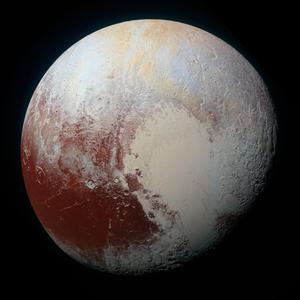Glossary term: Pluto
Description: Pluto is one of the celestial bodies in our Solar System. It is located in the Kuiper Belt, beyond the orbit of Neptune. It used to be known as the ninth Solar System planet, but in 2006 it was reclassified as a dwarf planet. It was discovered in 1930 by Clyde Tombaugh. Pluto's average distance from the Sun is 6 billion kilometers (km), and its radius is 1185 km (smaller than the Earth's moon). One year on Pluto is equivalent to 247.9 Earth years and its day is equivalent to 6.4 Earth days.
NASA's New Horizon mission was the first spacecraft to fly by Pluto, in 2015, and provided the first ever detailed view of its surface and its atmosphere. The surface of Pluto is so cold that very little of the hydrogen can exist in gaseous form. What little atmosphere Pluto has is mainly nitrogen, and the surface has large plains of frozen nitrogen. Its atmosphere extends to a distance of 1600 km. Pluto is composed of rocks (70%) and ice (30%). It has five known moons: Charon, Styx, Nix, Kerberos, and Hydra.
Related Terms:
See this term in other languages
Term and definition status: This term and its definition have been approved by a research astronomer and a teacher
The OAE Multilingual Glossary is a project of the IAU Office of Astronomy for Education (OAE) in collaboration with the IAU Office of Astronomy Outreach (OAO). The terms and definitions were chosen, written and reviewed by a collective effort from the OAE, the OAE Centers and Nodes, the OAE National Astronomy Education Coordinators (NAECs) and other volunteers. You can find a full list of credits here. All glossary terms and their definitions are released under a Creative Commons CC BY-4.0 license and should be credited to "IAU OAE".
If you notice a factual error in this glossary definition then please get in touch.
Related Media
Pluto
Credit: NASA/Johns Hopkins University Applied Physics Laboratory/Southwest Research Institute credit link
License: PD Public Domain icons
Related Activities
Children's Planetary Maps: Pluto & Charon
astroEDU educational activity (links to astroEDU website) Description: Learn about our furthest neighbors
License: CC-BY-4.0 Creative Commons Attribution 4.0 International (CC BY 4.0) icons
Tags:
Maps
, Planetary cartography
, Spatial thinking
, Charon
Age Ranges:
6-8
, 8-10
, 10-12
, 12-14
Education Level:
Middle School
, Primary
, Secondary
Areas of Learning:
Social Research
Costs:
Low Cost
Duration:
2 hours
Group Size:
Group
Skills:
Analysing and interpreting data
, Asking questions
, Communicating information
, Constructing explanations
, Developing and using models
, Engaging in argument from evidence
, Planning and carrying out investigations










